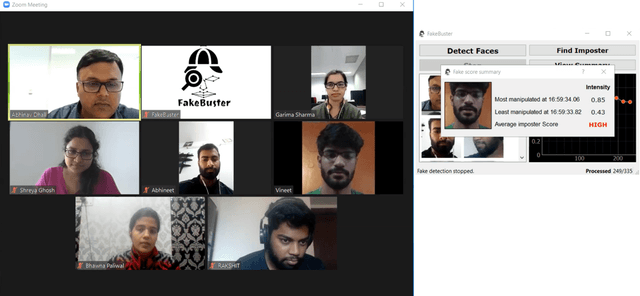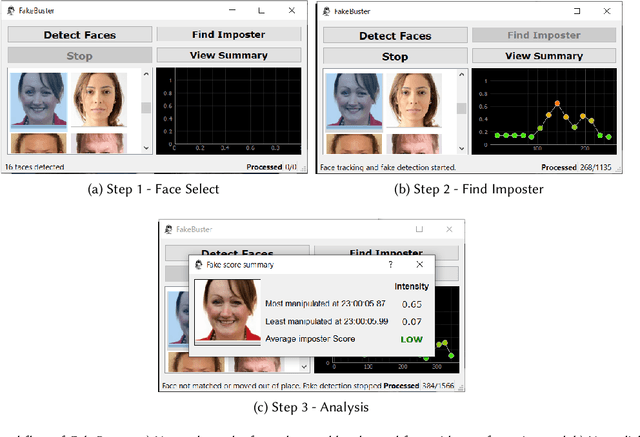Parul Gupta
Conditional Distribution Modelling for Few-Shot Image Synthesis with Diffusion Models
Apr 29, 2024Abstract:Few-shot image synthesis entails generating diverse and realistic images of novel categories using only a few example images. While multiple recent efforts in this direction have achieved impressive results, the existing approaches are dependent only upon the few novel samples available at test time in order to generate new images, which restricts the diversity of the generated images. To overcome this limitation, we propose Conditional Distribution Modelling (CDM) -- a framework which effectively utilizes Diffusion models for few-shot image generation. By modelling the distribution of the latent space used to condition a Diffusion process, CDM leverages the learnt statistics of the training data to get a better approximation of the unseen class distribution, thereby removing the bias arising due to limited number of few shot samples. Simultaneously, we devise a novel inversion based optimization strategy that further improves the approximated unseen class distribution, and ensures the fidelity of the generated samples to the unseen class. The experimental results on four benchmark datasets demonstrate the effectiveness of our proposed CDM for few-shot generation.
DiffAugment: Diffusion based Long-Tailed Visual Relationship Recognition
Jan 01, 2024Abstract:The task of Visual Relationship Recognition (VRR) aims to identify relationships between two interacting objects in an image and is particularly challenging due to the widely-spread and highly imbalanced distribution of <subject, relation, object> triplets. To overcome the resultant performance bias in existing VRR approaches, we introduce DiffAugment -- a method which first augments the tail classes in the linguistic space by making use of WordNet and then utilizes the generative prowess of Diffusion Models to expand the visual space for minority classes. We propose a novel hardness-aware component in diffusion which is based upon the hardness of each <S,R,O> triplet and demonstrate the effectiveness of hardness-aware diffusion in generating visual embeddings for the tail classes. We also propose a novel subject and object based seeding strategy for diffusion sampling which improves the discriminative capability of the generated visual embeddings. Extensive experimentation on the GQA-LT dataset shows favorable gains in the subject/object and relation average per-class accuracy using Diffusion augmented samples.
FakeBuster: A DeepFakes Detection Tool for Video Conferencing Scenarios
Jan 09, 2021


Abstract:This paper proposes a new DeepFake detector FakeBuster for detecting impostors during video conferencing and manipulated faces on social media. FakeBuster is a standalone deep learning based solution, which enables a user to detect if another person's video is manipulated or spoofed during a video conferencing based meeting. This tool is independent of video conferencing solutions and has been tested with Zoom and Skype applications. It uses a 3D convolutional neural network for predicting video segment-wise fakeness scores. The network is trained on a combination of datasets such as Deeperforensics, DFDC, VoxCeleb, and deepfake videos created using locally captured (for video conferencing scenarios) images. This leads to different environments and perturbations in the dataset, which improves the generalization of the deepfake network.
The eyes know it: FakeET -- An Eye-tracking Database to Understand Deepfake Perception
Jun 18, 2020



Abstract:We present \textbf{FakeET}-- an eye-tracking database to understand human visual perception of \emph{deepfake} videos. Given that the principal purpose of deepfakes is to deceive human observers, FakeET is designed to understand and evaluate the ease with which viewers can detect synthetic video artifacts. FakeET contains viewing patterns compiled from 40 users via the \emph{Tobii} desktop eye-tracker for 811 videos from the \textit{Google Deepfake} dataset, with a minimum of two viewings per video. Additionally, EEG responses acquired via the \emph{Emotiv} sensor are also available. The compiled data confirms (a) distinct eye movement characteristics for \emph{real} vs \emph{fake} videos; (b) utility of the eye-track saliency maps for spatial forgery localization and detection, and (c) Error Related Negativity (ERN) triggers in the EEG responses, and the ability of the \emph{raw} EEG signal to distinguish between \emph{real} and \emph{fake} videos.
Not made for each other- Audio-Visual Dissonance-based Deepfake Detection and Localization
Jun 01, 2020



Abstract:We propose detection of deepfake videos based on the dissimilarity between the audio and visual modalities, termed as the Modality Dissonance Score (MDS). We hypothesize that manipulation of either modality will lead to dis-harmony between the two modalities, eg, loss of lip-sync, unnatural facial and lip movements, etc. MDS is computed as an aggregate of dissimilarity scores between audio and visual segments in a video. Discriminative features are learnt for the audio and visual channels in a chunk-wise manner, employing the cross-entropy loss for individual modalities, and a contrastive loss that models inter-modality similarity. Extensive experiments on the DFDC and DeepFake-TIMIT Datasets show that our approach outperforms the state-of-the-art by up to 7%. We also demonstrate temporal forgery localization, and show how our technique identifies the manipulated video segments.
 Add to Chrome
Add to Chrome Add to Firefox
Add to Firefox Add to Edge
Add to Edge